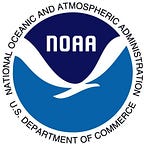Discover DSCOVR
NOAA’s Newest Satellite — America’s First Defense against Space Weather
By Dr. Stephen Volz, NOAA’s Satellite and Information Service
Dr. Stephen Volz directs NOAA’s Satellite and Information Service. Learn more about this latest satellite milestone.
About a million miles away, at a point between Earth and the Sun, orbits DSCOVR — a powerful new satellite that will serve as America’s primary warning system for solar magnetic storms (“space weather”) that can disrupt power grids, aviation, telecommunications and GPS systems on Earth.
Those who live in the Northern latitudes know space weather best as aurora borealis, or Northern Lights, which provides a stunning night show of vivid colors. Despite its beauty, the potential impacts these storms pose on our power systems could be extremely costly.
In 2013, a Lloyds of London study predicted that the most extreme space weather storms could affect 20 to 40 million people in the U.S. and cause up to $2.6 trillion in damages, with recovery taking up to two years. Smaller storms would not cause as much damage, but could still significantly affect our lives if we are unprepared.
This is precisely why our nation needs DSCOVR. Launched earlier this year, the satellite (short for Deep Space Climate Observatory) gives forecasters at NOAA’s Space Weather Prediction Center early warning when a surge of storm energy is detected. This improves their ability to warn power providers, phone companies, and others of potentially harmful solar activity, up to an hour before it reaches Earth. These warnings give companies time to take actions to prevent damage and disruption.
By spring 2016, DSCOVR will be America’s first operational deep space satellite and become a vital piece of our international space weather observing system. DSCOVR also has a few other exciting tools that are helping to track climate change on Earth. Specifically, the satellite has two NASA Earth-observing instruments that will watch the Earth at Noon continuously and gather a range of measurements, from ozone, atmospheric aerosols and other potent heat-trapping gases.
DSCOVR is a partnership between NOAA, NASA and the U.S. Air Force and as of this week NASA officially handed over command of the spacecraft today to NOAA satellite operators in Suitland, Maryland, and forecasters in Boulder, Colorado. For more information about DSCOVR, please visit: www.nesdis.noaa.gov/DSCOVR.
Dr. Stephen Volz is the assistant administrator for NOAA’s National Environmental Satellite and Data Information Service.
